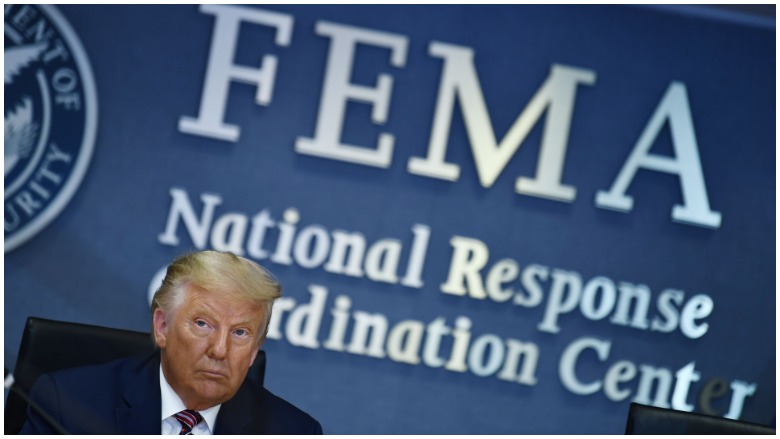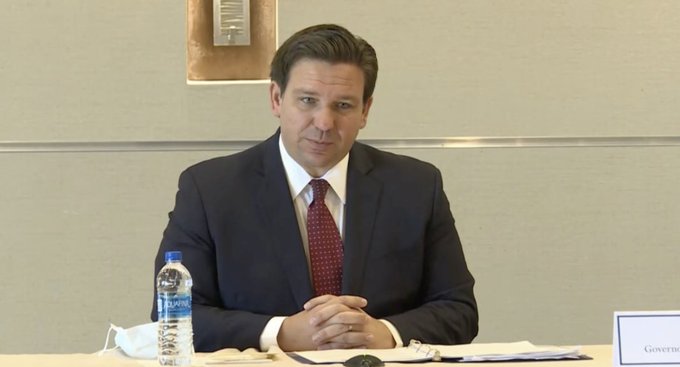
Getty Trump at the Federal Emergency Management Agency to discuss ways to address the devastation caused by Hurricane Laura.
Many unemployed Americans breathed a sigh of relief when President Donald Trump announced that the Lost Wages Assistance (LWA) program would replace the weekly $600 supplement in unemployment benefits that expired at the end of July.
However, some have become concerned that the program could run out of money much sooner than anticipated.
More than two-thirds of the states across the country have been approved for the program, according to FEMA (Federal Emergency Management Agency), and a few have begun distributing payments. Here’s what you need to know about when the program is expected to end and how one of the program’s eligibility requirements means some of the poorest Americans have been excluded.
Natural Disasters & Other Factors Could Lead the Lost Wages Assistance Program to Run out of Money Sooner Than Anticipated
The LWA program provides $300 to $400 in lost wages to eligible unemployment benefits recipients. In Trump’s August 8 memo about LWA, he announced that FEMA, which typically assists states in moments of crisis associated with natural disasters, would be administering the payments. The program will end either (a) December 27, 2020, (b) whenever FEMA’s Disaster Relief Fund (DRF) drops to $25 billion or (c) whenever Congress passes another stimulus bill.
There are 34 states across the country that have been approved for LWA: Ohio, Virginia, Maine, Arkansas, Connecticut, Pennsylvania, Washington, New Hampshire, New York, Alaska, Georgia, Vermont, Mississippi, Tennessee, Rhode Island, Massachusetts, Alabama, California, Indiana, North Carolina, Texas, Kentucky, Michigan, Maryland, Idaho, Oklahoma, Montana, Arizona, Iowa, Louisiana, New Mexico, Colorado, Missouri and Utah.
The more states that are approved, the quicker the money will run out and FEMA has only guaranteed that it would issue three weeks’ worth of payments.
An article from The Century Foundation estimated, “Delivering the $300 per week to the approximately 24 million Americans eligible will cost more than $7 billion a week, depleting the $44 billion in just six weeks. However, the Disaster Relief Fund only has $68 billion in it in total right now …”
Even South Carolina’s Department of Employment sent a letter to the state’s governor warning him that they believe LWA “would reduce the DRF to $25 billion well before December 27, 2020.”
In addition to the costs of the program, there is also a possibility that FEMA’s DRF could be decreased by natural disasters, such as the derecho storm which recently wrecked towns across the midwest, and Hurricane Laura, which has already caused severe damage to countless homes and businesses around the Gulf (and whose relief costs are unknown at the moment).
One Eligibility Requirement of the Program Excludes Millions of Americans, CNBC Says
One big criticism of Trump’s LWA program is that, according to his August 8 memo, individuals would only be considered eligible if they had already been receiving at least $100 per week in unemployment benefits. According to a CNBC analysis of August 20 unemployment data, 5.5 million Americans would most likely be considered ineligible due to this requirement.
Forbes had earlier predicted that the measure would have a negative and disproportionate impact on “low-earners, part-time workers and gig workers” as well as “younger workers and workers juggling childcare responsibilities” and “female workers.”
CNBC also reported that Trump’s directive on evictions only asks federal agencies to look at how to prevent them instead of banning evictions outright; therefore, millions of those Americans ineligible for expanded unemployment benefits could face eviction from their homes.
The fact that LWA has left out so many low-wage earners has only increased the urgency on Congress to come to a consensus on a second round of stimulus checks. However, both sides appear to remain at an impasse and Congress will not return to session until September.
READ NEXT: Who’s Distributing Up To $400 Extra In Unemployment Benefits? FEMA
